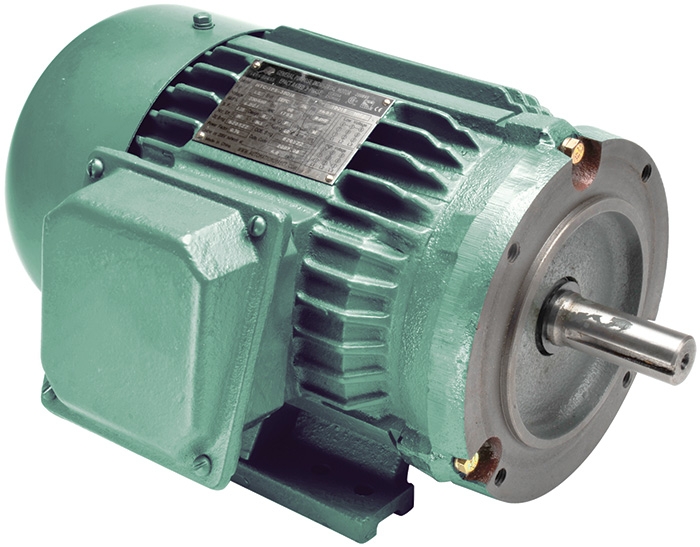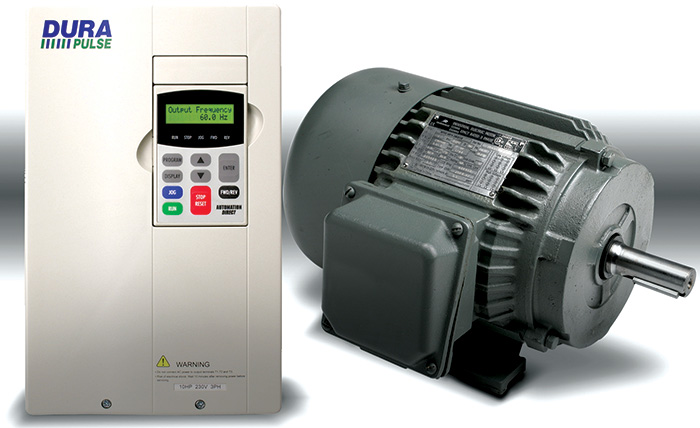The Energy Policy and Conservation Act (EPCA) of 1975 started the U.S. Department of Energy’s (DOE) involvement in setting energy conservation standards for industrial, commercial, and consumer products and equipment. There are more than 60 categories of equipment and applications in these energy standards, affecting 30 percent of industrial energy use and more than 90 percent of consumer energy use. Many appliances such as air conditioners, heaters, refrigerators and stoves are covered in these standards. The EPCA also includes pumps, motors and compressors used in industrial applications (see Image 1). Energy efficiency rules of interest to the industrial sector can be found in the Code of Federal Regulations at 10 CFR, Part 431—Energy Efficiency Program for Certain Commercial and Industrial Equipment.
 Image 1. NEMA premium efficiency motors play a big role in energy conservation in industrial, commercial and consumer products and applications. (Courtesy of AutomationDirect)
Image 1. NEMA premium efficiency motors play a big role in energy conservation in industrial, commercial and consumer products and applications. (Courtesy of AutomationDirect)Creating DOE Rules
Anytime the DOE creates, or amends efficiency requirements, a four-phase rulemaking process is followed. It takes about three years to complete the rulemaking process, and the DOE encourages interested parties to participate and comment throughout the this period of time. Phase one is the framework, which includes requests for information and test procedures to evaluate energy consumption. Phase two includes preliminary analysis of the technology and economics of the standard. Phase three includes the notice of proposed rulemaking, and creation and proposal of the rule. Phase four is notice and issuance of the final rule, which is free to download online at the DOE website.Motor Efficiency Standards
Most new and some existing pumping systems use high efficiency motors. All new installations must comply with the following rules. The motor efficiency rulemaking process for 10 CFR Part 431, Subpart B made final in May of 2014 was recently completed and became effective June 1, 2016. This amended rule covers energy conservation requirements for electric motor efficiency, 1 to 200 hp. Most single-speed induction motors must meet the premium efficiency level. The big change was eliminating loop holes in the rule, but not much else was changed. Single-phase and polyphase motors rated from one-fourth to 3 horsepower (HP) are covered in the small motor efficiency standard 10 CFR Part 431, Subpart X—Small Electric Motors. Basically, all small electric motors sold in the U.S. must meet minimum efficiency standards. Pump and heating, ventilation and air conditioning (HVAC) applications are greatly impacted by this rule due to their extensive use of small motors. Some motors required redesign due to changes finalized in 2015. However, small motor rules will likely expand in scope soon as current coverage is limited with many small, special-purpose motors exempt. They could eliminate the overlap with the motor efficiency standard in Subpart B. Image 2. Variable frequency drives and motors can save significant energy by controlling motor speed, yet no government efficiency standards exist for VFDs.
Image 2. Variable frequency drives and motors can save significant energy by controlling motor speed, yet no government efficiency standards exist for VFDs.VFD Voluntary Standard
Pumping systems using VFDs to control motor and pump speed should consider following this standard that is now voluntary, but will probably be made mandatory soon. The motor efficiency rule only affects motors designed to be started across the line, meaning without a soft starter, VFD or other component that would limit inrush current. The rule exempts inverter quality motors. Producing rated torque across a wide rpm range is the primary design focus for most manufacturers of inverter-rated motors, with efficiency a secondary goal. Optimizing a motor’s rotor and stator for pulse width modulation from a VFD and high magnetizing flux doesn’t always correlate with improved efficiency. Although not DOE driven, voluntary VFD efficiency standards include VFD test standard AHRI 1210 and AHRI Certification Program for VFDs. Expect manufacturers’ interest to grow along with that of their customers.New Standards
There are some new rules, or rules in progress, relating to fans and blowers, air compressors and pumps. The final rule for Energy Conservation Standards for Pumps, Federal Register, 81 FR 4368, was issued January 26, 2016. Compliance with this regulation, 10 CFR Part 431, Subpart Y, is required on or before January 27, 2020. The amended rule adopts new energy conservation requirements, definitions and test procedures for pumps, defined as equipment to move liquids by physical or mechanical action. It is for rotodynamic, clean water pumps used in commercial, industrial, agricultural and municipal applications..jpg) Image 3. New and existing energy conservation standards exist for pumps, and more are moving through the rulemaking process.
Image 3. New and existing energy conservation standards exist for pumps, and more are moving through the rulemaking process.
